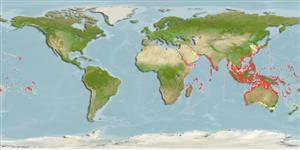Klassifizierung / Names
Namen | Synonyme | Catalog of Fishes(Gattung, Arten) | ITIS | CoL | WoRMS | Cloffa
Environment: milieu / climate zone / depth range / distribution range
Ökologie
seewasser; brackwasser riff-verbunden; tiefenbereich 3 - 58 m (Ref. 1602). Tropical; 36°N - 48°S, 24°E - 132°W
Indo-Pacific: Red Sea and East Africa eastward through Indonesia to Tuamotus, northward to southern Japan, southward to Lord Howe Island.
Size / Gewicht / Alter
Maturity: Lm ? range ? - ? cm
Max length : 120 cm TL Männchen/unbestimmt; (Ref. 9710); common length : 54.0 cm TL Männchen/unbestimmt; (Ref. 5450)
Rückenflossenstacheln (insgesamt) : 0; Rückenflossenweichstrahlen (insgesamt) : 10 - 12; Afterflossenstacheln: 0; Afterflossenweichstrahlen: 10 - 11. Body covered with prickles (Ref. 559). Juveniles with dark stripes on belly, becoming spots with growth; adults with or without spots on fin (Ref. 4919).
Relatively uncommon in patch reefs and coral slopes near sandy areas of clear lagoon and seaward reefs. Juveniles occur in sandy and weedy inner reefs, adults on clear lagoons and seaward reefs (Ref. 9710). Juveniles inshore, usually on muddy substrates and often estuarine. Adults on deep slopes and range to outer reefs, sometimes swimming high above the substrate or just below the surface. Pelagic larvae may disperse over great distance and juveniles occur in subtropical zone (Ref. 48637). Enter estuaries (Ref. 4833). Considered as the giant among puffers reaching a total length well in excess of a meter.
Life cycle and mating behavior
Geschlechtsreife | Fortpflanzung | Ablaichen | Eier | Fecundity | Larven
Masuda, H., K. Amaoka, C. Araga, T. Uyeno and T. Yoshino, 1984. The fishes of the Japanese Archipelago. Vol. 1. Tokai University Press, Tokyo, Japan. 437 p. (text). (Ref. 559)
IUCN Rote Liste Status (Ref. 130435: Version 2024-1)
Bedrohung für Menschen
Poisonous to eat (Ref. 559)
Nutzung durch Menschen
Fischereien: nicht kommerziell
Tools
Zusatzinformationen
Download XML
Internet Quellen
Estimates based on models
Preferred temperature (Ref.
123201): 22.4 - 29, mean 27.8 °C (based on 1224 cells).
Phylogenetic diversity index (Ref.
82804): PD
50 = 0.5000 [Uniqueness, from 0.5 = low to 2.0 = high].
Bayesian length-weight: a=0.04898 (0.02995 - 0.08010), b=2.86 (2.72 - 3.00), in cm total length, based on LWR estimates for this species & Genus-body shape (Ref.
93245).
Trophic level (Ref.
69278): 3.7 ±0.2 se; based on diet studies.
Widerstandsfähigkeit (Ref.
120179): niedrig, Verdopplung der Population dauert 4,5 - 14 Jahre. (Preliminary K or Fecundity.).
Fishing Vulnerability (Ref.
59153): High to very high vulnerability (72 of 100).
Nutrients (Ref.
124155): Calcium = 18 [7, 47] mg/100g; Iron = 0.429 [0.222, 0.944] mg/100g; Protein = 18.9 [16.7, 21.0] %; Omega3 = 0.102 [0.053, 0.196] g/100g; Selenium = 45.7 [22.5, 100.0] μg/100g; VitaminA = 28.6 [7.6, 110.0] μg/100g; Zinc = 0.832 [0.550, 1.275] mg/100g (wet weight);
